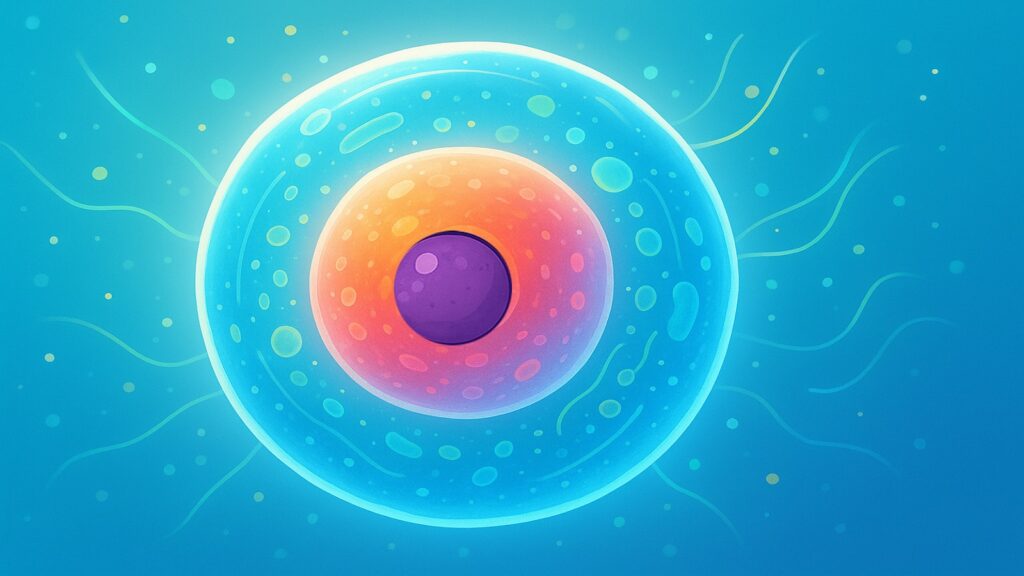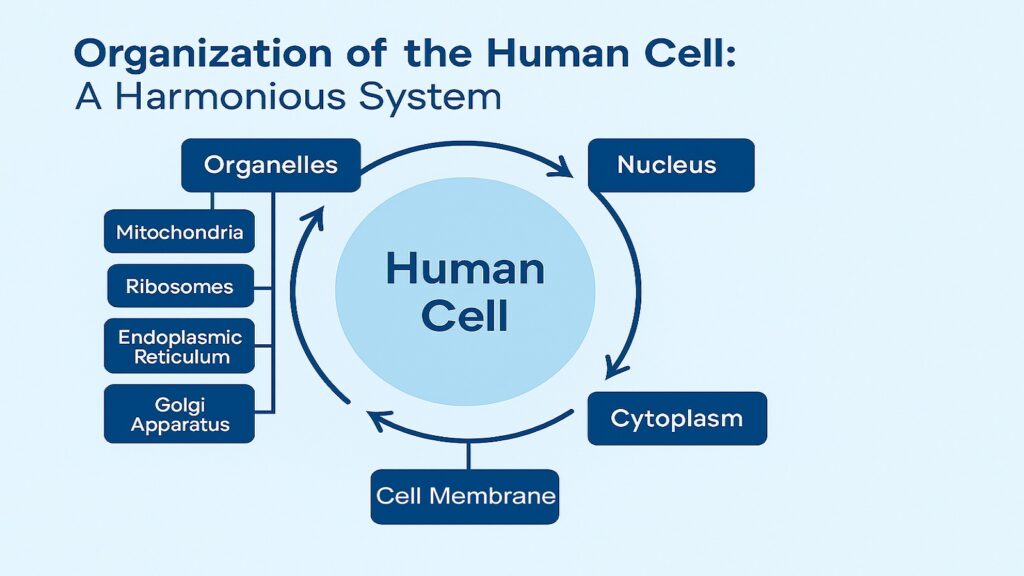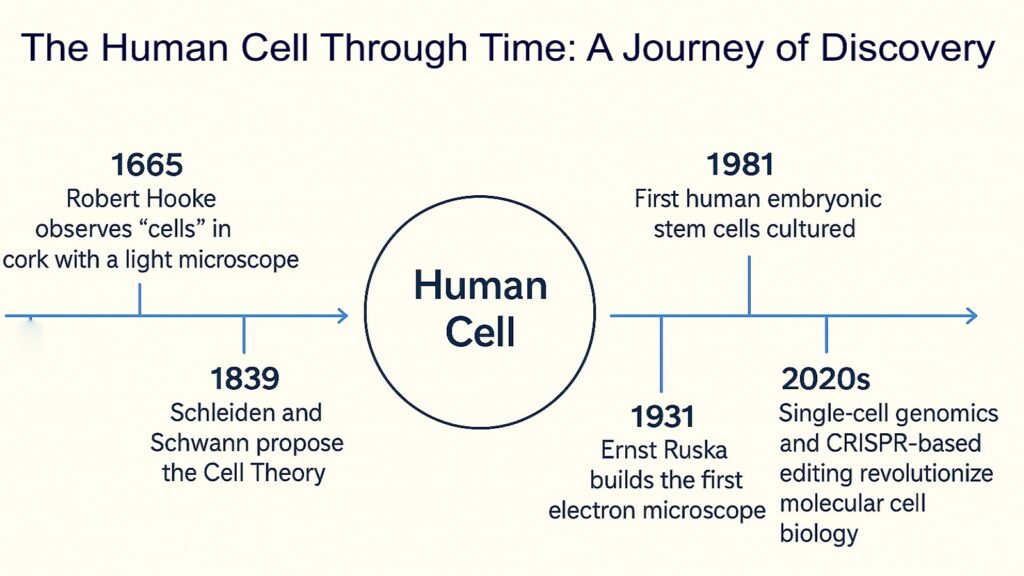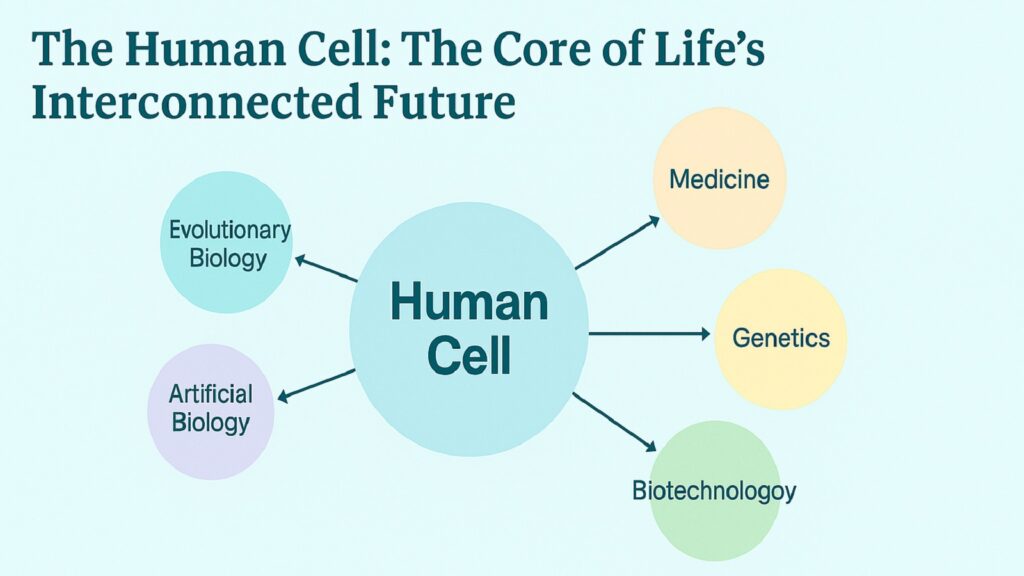Table of Contents
Introduction: The Human Cell — Gateway to Life’s Deepest Secrets

Every living moment begins within a tiny enclosed space no wider than a human hair. The human cell represents both the simplest expression of life and its most elaborate achievement. Within this microscopic universe, thousands of chemical reactions unfold each second, transforming nutrients into energy, copying genetic instructions, and building proteins that shape our very existence. This cellular machinery connects us to the earliest organisms that emerged billions of years ago, when primitive membranes first separated life from non-life.
The human cell carries a paradox within its boundaries. It functions as a self-contained factory, yet depends entirely on cooperation with trillions of other cells. It follows ancient blueprints inherited from single-celled ancestors, yet performs tasks of stunning complexity. Understanding these cellular secrets bridges the gap between biology’s primordial origins and the cutting edge of modern science. Through six essential insights, this article reveals how cells govern everything from our first breath to our last heartbeat, and why their study remains central to unlocking life’s remaining mysteries.
Essential Components of the Human Cell
| Components Of Human Cell | Primary Function |
|---|---|
| Nucleus | Houses DNA and controls cellular activities through gene expression |
| Mitochondria | Generates ATP through cellular respiration to power cellular processes |
| Ribosomes | Synthesizes proteins by translating messenger RNA sequences |
| Endoplasmic Reticulum | Processes and transports proteins and lipids throughout the cell |
| Golgi Apparatus | Modifies, packages, and distributes proteins and lipids to destinations |
| Cell Membrane | Regulates entry and exit of substances while maintaining cellular integrity |
| Cytoplasm | Provides medium for organelles and site for metabolic reactions |
| Lysosomes | Digests waste materials and cellular debris through enzymatic breakdown |
| Cytoskeleton | Maintains cell shape and enables movement and intracellular transport |
| Centrosomes | Organizes microtubules and regulates cell division and chromosome separation |
1. The Human Cell as the Fundamental Unit of Life
The recognition that cells form the basic unit of all living things transformed biology from descriptive observation into mechanistic science. Before this realization, scientists debated whether life emerged from spontaneous generation or followed specific organizational rules. Cell theory resolved this debate by establishing three core principles that still guide modern biology. All organisms consist of one or more cells. The cell represents the smallest unit capable of independent life. New cells arise only from pre-existing cells through division.
This framework explains why damaging even a single cell type can compromise entire organ systems. Red blood cells transport oxygen despite lacking nuclei, demonstrating how specialized cells sacrifice certain features to excel at specific tasks. Neurons stretch over a meter in length while maintaining communication across vast distances within the body. Muscle cells contract in coordinated waves to generate movement. Each cell type performs distinct functions, yet all share fundamental characteristics that define life itself.
The human body contains approximately 37 trillion cells, each descended from a single fertilized egg. This staggering number reflects countless rounds of division, differentiation, and specialization. Cells cooperate through chemical signals that coordinate growth, repair, and maintenance. When this coordination fails, diseases like cancer emerge from cells that ignore normal growth limits. Understanding cells as fundamental units helps explain both health and disease at their most basic level.
Core Principles of Cell Theory
| Principle | Scientific Significance |
|---|---|
| All living organisms are composed of cells | Establishes universal structural basis for life across all species |
| Cell is the basic unit of life | Defines minimum organization required for metabolic and reproductive processes |
| Cells arise from pre-existing cells | Eliminates spontaneous generation and confirms biological continuity |
| Cells contain hereditary information | Explains how traits pass between generations through DNA transmission |
| Chemical composition is similar across cells | Reveals evolutionary relationships and common origin of life |
| Energy flow occurs within cells | Identifies cellular metabolism as foundation of all biological work |
2. The Human Cell’s Structure: A Symphony of Organized Complexity

Walk inside a human cell and you enter a world of compartmentalized efficiency. The cell membrane stands as the first boundary, a double layer of lipids studded with proteins that act as gates and sensors. This barrier maintains the distinct internal environment required for life while remaining selectively permeable. Beyond this membrane lies the cytoplasm, a gel-like substance where countless biochemical reactions occur simultaneously without interference.
The nucleus commands this cellular symphony from its position near the cell’s center. Wrapped in its own double membrane, the nucleus stores DNA on chromosomes and coordinates which genes become active at any moment. Messenger RNA molecules carry instructions from nucleus to cytoplasm, where ribosomes translate them into proteins. These proteins then fold into specific shapes that determine their function, whether as enzymes accelerating reactions or structural components building cellular architecture.
Mitochondria float through the cytoplasm like miniature power plants, converting glucose and oxygen into usable energy in the form of ATP molecules. These organelles carry their own DNA, a remnant from their origin as independent bacteria that merged with primitive cells billions of years ago. The endoplasmic reticulum forms an extensive network of folded membranes where proteins undergo initial processing. From there, the Golgi apparatus adds final modifications before packaging proteins for transport. This organized complexity allows cells to perform hundreds of tasks simultaneously while maintaining precise control over each process.
Human Cell: Major Structural Components and Their Functions
| Structure | Essential Role in Cellular Function |
|---|---|
| Plasma Membrane | Separates internal environment and controls molecular traffic bidirectionally |
| Nuclear Envelope | Protects genetic material and regulates RNA and protein passage |
| Mitochondrial Matrix | Contains enzymes for citric acid cycle and ATP synthesis reactions |
| Rough Endoplasmic Reticulum | Synthesizes membrane-bound and secretory proteins with ribosomal attachment |
| Smooth Endoplasmic Reticulum | Produces lipids, metabolizes carbohydrates, and detoxifies harmful substances |
| Cytoskeletal Filaments | Provides mechanical support and generates forces for cellular movement |
3. The Human Cell’s Difference from Plant and Bacterial Cells
Evolution shaped cells along divergent paths that reflect different survival strategies. Human cells belong to the eukaryotic lineage, characterized by membrane-bound organelles and a nucleus that sequesters genetic material. Plant cells share this eukaryotic heritage but developed additional features that enable photosynthesis and structural rigidity. Their rigid cell walls, composed of cellulose, provide support that allows plants to grow upright without skeletons. Large central vacuoles store water and maintain turgor pressure, while chloroplasts capture sunlight and convert it into chemical energy.
Bacterial cells represent an entirely different organizational strategy. These prokaryotic cells lack internal membrane-bound compartments, keeping all cellular machinery within a single open space. Their DNA floats freely in a region called the nucleoid rather than being enclosed in a nucleus. This simpler organization allows bacteria to reproduce rapidly and adapt quickly to changing environments. Some bacteria possess flagella for movement or pili for exchanging genetic material. Their cell walls, made of peptidoglycan rather than cellulose, provide protection while maintaining flexibility.
These structural differences have profound implications for medicine and evolution. Antibiotics target features unique to bacterial cells, such as cell wall synthesis or bacterial ribosomes, allowing selective destruction of pathogens without harming human cells. The absence of chloroplasts in human cells means we must consume organic compounds for energy rather than producing them from sunlight. Understanding these distinctions helps explain why organ transplants between species fail, why certain toxins affect only specific cell types, and how different organisms occupy distinct ecological niches. Each cell type represents a unique solution to the fundamental challenge of maintaining life.
Comparative Features Of Human Cell, Plant Cell, and Bacterial Cell
| Cell Type | Comparison Across Key Features |
|---|---|
| Human Cell | Nucleus present; mitochondria present; no cell wall; 10–30 µm; no chloroplasts; reproduces by mitosis and meiosis. |
| Plant Cell | Nucleus present; mitochondria present; has a cellulose cell wall; 10–100 µm; has chloroplasts; reproduces by mitosis and meiosis. |
| Bacterial Cell | No true nucleus (nucleoid region instead); no mitochondria; has a peptidoglycan cell wall; 0.2–2 µm; no chloroplasts; reproduces by binary fission. |
4. The Human Cell’s Journey of Discovery in Science

The story of cell discovery began with curiosity and crude tools. In 1665, Robert Hooke examined thin slices of cork under a primitive microscope and observed small compartments he named cells, thinking they resembled monastic rooms. He saw only the dead cell walls of plant tissue, not the living contents within. A decade later, Antonie van Leeuwenhoek improved lens grinding techniques and became the first person to observe living cells, describing the swimming animalcules we now know as protozoa and bacteria.
Progress remained slow for nearly two centuries until better microscopes revealed cellular details. In the 1830s, Matthias Schleiden and Theodor Schwann proposed that all plants and animals consist of cells, establishing the foundation of cell theory. Rudolf Virchow added the crucial insight that cells arise only from other cells, finally eliminating the notion of spontaneous generation. These conceptual breakthroughs preceded the technological revolution that would expose cellular machinery in unprecedented detail.
The twentieth century brought electron microscopy, which uses beams of electrons instead of light to achieve magnifications exceeding one million times. Scientists could finally visualize organelles, membranes, and even large protein complexes. Fluorescent microscopy allowed researchers to tag specific molecules with glowing markers and watch cellular processes unfold in living cells. The development of DNA sequencing revealed the genetic instructions cells follow. More recently, cryo-electron microscopy freezes samples at liquid nitrogen temperatures, preserving cellular structures in near-native states. Each advance peeled back another layer of cellular mystery, transforming our understanding from simple boxes to dynamic systems of staggering complexity.
Milestones in Cell Discovery Timeline
| Year | Discovery and Its Impact |
|---|---|
| 1665 | Robert Hooke observes and names cells in cork tissue samples |
| 1674 | Antonie van Leeuwenhoek describes living microorganisms under improved lenses |
| 1838-1839 | Schleiden and Schwann establish that all organisms consist of cells |
| 1855 | Rudolf Virchow declares that all cells come from pre-existing cells |
| 1953 | Watson and Crick determine DNA double helix structure from cellular nuclei |
| 1981 | Fluorescent protein tagging allows visualization of specific molecules in living cells |
5. The Human Cell in Medicine and Biotechnology
Modern medicine operates at the cellular level, targeting specific molecular pathways within cells to treat disease. Cancer therapies now include drugs that recognize unique markers on tumor cells while sparing healthy tissue. Immunotherapy harnesses the body’s own immune cells, training them to identify and destroy cancer cells more effectively. These approaches succeed because scientists understand the molecular signals cells use to communicate, divide, and die.
Stem cell research promises to revolutionize regenerative medicine by providing cells capable of becoming any tissue type. Embryonic stem cells retain the ability to differentiate into all cell types in the body, while induced pluripotent stem cells can be created from adult tissues by activating specific genes. Researchers have successfully grown functioning organs in laboratories, including miniature kidneys, livers, and brain organoids that mimic human tissue architecture. These cellular systems allow drug testing without animal experiments and may eventually provide replacement organs for transplantation.
Gene therapy represents another frontier where cellular knowledge translates into treatment. Scientists can now edit genes within living cells using tools like CRISPR-Cas9, correcting genetic defects that cause inherited diseases. In 2017, researchers used this technique to cure sickle cell disease in patients by editing blood stem cells and returning them to the body. Cellular engineering extends beyond medicine into industrial applications. Genetically modified cells produce insulin for diabetics, synthesize biofuels, and manufacture complex pharmaceuticals. Understanding cells at molecular resolution enables precise interventions that were science fiction only decades ago.
Breakthrough Applications of Cellular Research
| Application Field | Key Achievement and Clinical Impact |
|---|---|
| Cancer Immunotherapy | CAR-T cells engineered to target and eliminate specific tumor types |
| Stem Cell Therapy | Induced pluripotent stem cells generated from adult tissue for regeneration |
| Gene Editing Medicine | CRISPR correction of mutations causing sickle cell disease in patients |
| Insulin Production | Recombinant DNA technology enables bacterial cells to produce human insulin |
| Tissue Engineering | Laboratory-grown organoids replicate organ function for drug testing purposes |
| Vaccine Development | Cell culture systems produce viral vaccines without using live pathogens |
6. Human Cell as the Frontier of Future Biological Research
The next chapter in cellular science ventures into territories that challenge our basic assumptions about life. Synthetic biology aims to design cells from scratch, combining natural and artificial components to create organisms with novel capabilities. Scientists have successfully constructed minimal genomes containing only essential genes, revealing the bare requirements for cellular life. These stripped-down cells serve as chassis for engineering new metabolic pathways that produce valuable compounds or sense environmental contaminants.
Nanomedicine operates at scales smaller than cells themselves, using engineered nanoparticles that can cross cellular membranes and deliver drugs to specific organelles. Researchers have created molecular machines that patrol the bloodstream, detecting disease markers and releasing medication only when needed. These devices operate autonomously within living tissues, representing a convergence of biology and engineering that previous generations could barely imagine.
Perhaps the most profound frontier involves understanding consciousness and cognition at the cellular level. Neuroscientists now map how networks of neurons generate thoughts, memories, and emotions through patterns of electrical and chemical signals. Brain organoids grown in laboratories develop spontaneous neural activity resembling primitive brain waves. Quantum biology investigates whether quantum mechanical effects play roles in cellular processes like photosynthesis and enzyme catalysis. Some researchers speculate that quantum phenomena may contribute to how cells process information. As we probe deeper into cellular mechanisms, the boundary between living and non-living matter becomes increasingly difficult to define. Future research will continue revealing how these microscopic entities generate the full spectrum of biological complexity.
Emerging Frontiers in Cellular Science
| Research Area | Transformative Potential and Direction |
|---|---|
| Synthetic Minimal Cells | Creating artificial life forms with designer genomes for specific functions |
| Cellular Reprogramming | Converting one cell type directly into another without stem cell intermediates |
| Nanoscale Drug Delivery | Engineered particles target specific cells and release medication on demand |
| Brain Organoid Development | Laboratory-grown neural tissue models consciousness and neurological disease |
| Quantum Biology Studies | Investigating quantum effects in cellular processes like photosynthesis and enzymes |
| Longevity Research | Understanding cellular aging mechanisms to extend healthy human lifespan |
Conclusion: The Human Cell — Uniting Life, Science, and the Future

The human cell remains the common thread connecting all biological inquiry. From the earliest microscopic observations to cutting-edge genetic engineering, cellular research has driven every major advance in life sciences. These tiny structures embody both our evolutionary past and our biomedical future. They reveal how simple chemical reactions, properly organized, generate the phenomenon we call life. They demonstrate how complexity emerges from basic principles repeated across scales.
Different Types of Human Cells
| Human Cell Type | Main Function and Features |
|---|---|
| Blood Cells | Include red blood cells (carry oxygen), white blood cells (fight infection), and platelets (help in clotting). Found in the bloodstream and bone marrow. |
| Muscle Cells | Elongated and contractile; responsible for body movement and posture. Includes skeletal, cardiac, and smooth muscle cells. |
| Bone Cells | Maintain and remodel bone tissue. Include osteoblasts (form bone), osteoclasts (break down bone), and osteocytes (maintain bone matrix). |
| Nerve Cells (Neurons) | Transmit electrical signals throughout the body; essential for communication and control. |
| Skin Cells (Epithelial Cells) | Form protective barriers; line surfaces of organs and body cavities. |
| Stem Cells | Undifferentiated cells that can develop into other specialized cell types as needed. |
| Liver Cells (Hepatocytes) | Carry out metabolism, detoxification, and storage of nutrients. |
| Fat Cells (Adipocytes) | Store energy in the form of fat and help regulate body temperature and hormones. |
| Reproductive Cells | Include sperm cells and egg cells, responsible for passing genetic material to offspring. |
Understanding cells transforms how we approach disease, aging, and human enhancement. It clarifies the reasons behind the effectiveness of certain treatments and the ineffectiveness of others. It reveals the deep relationships connecting all living organisms through shared cellular machinery inherited from common ancestors. As technology advances, our view into cellular processes grows ever sharper, exposing new layers of organization and control. The questions we ask about cells today will shape the medicine, biotechnology, and perhaps even the definition of life itself tomorrow.
Future explorations will delve into specialized cell types, from the electrical sophistication of neurons to the contractile power of muscle fibers to the chemical versatility of liver cells. Each cell type tells its own story while remaining fundamentally connected to the principles outlined here. The human cell stands as both the beginning and the destination of biological understanding, an endless source of discovery that rewards curiosity with insights into the nature of existence itself.
Comparison of Human Cell and Other Major Cell Types
| Cell Type | Comparison with Human Cell |
|---|---|
| Human Cell | Eukaryotic, multicellular, has nucleus and membrane-bound organelles; forms tissues and organs in the human body. |
| Plant Cell | Also eukaryotic but has a rigid cell wall, chloroplasts for photosynthesis, and a large central vacuole. |
| Bacterial Cell (Prokaryotic) | Lacks nucleus and organelles; genetic material floats freely in cytoplasm; much smaller than human cells. |
| Fungal Cell | Eukaryotic like human cells but has a chitin cell wall and may be multicellular or unicellular (yeasts). |
| Protist Cell | Single-celled eukaryotes; share features with human cells but often move using cilia or flagella; diverse in function. |
| Archaeal Cell | Prokaryotic, similar in size to bacteria but with distinct biochemistry and genes; found in extreme environments. |
| Animal Cell (General) | Human cells are specialized animal cells; all lack cell walls and chloroplasts but share membrane and organelles. |
| Yeast Cell | Unicellular fungus; eukaryotic with similar organelles to human cells, often used as a model in human genetics research. |
| Algal Cell | Eukaryotic with chloroplasts like plant cells; capable of photosynthesis but lacks the complexity of human cell systems. |
Read More Science and Space Related Articles
- Black Hole Singularity: 6 Mind-Blowing Truths Explained
- 6 Incredible Ways Missiles Obey The Laws of Physics
- Peaches: 6 Fascinating Secrets of Genetic Evolution
- Cherries Reveal 6 Powerful Secrets of Their Red Glow
- Type 2 Diabetes Weds Bitter Gourd: The Bitter Truth
- Anthropomorphism: 6 Brilliant Benefits and Risks in AI
- Millisecond Pulsars: 6 Incredible Insights Driving Science
- AI and Consciousness: 8 Exciting Concepts Driving Research




